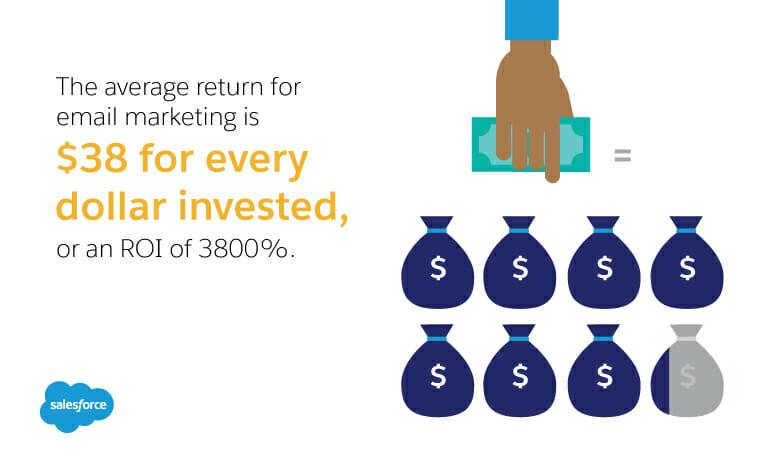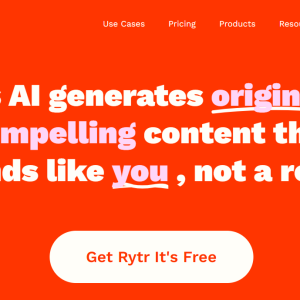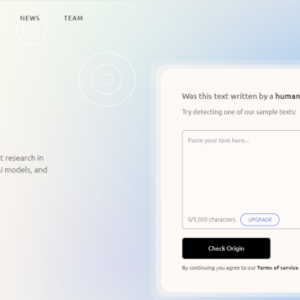In today’s digital age, businesses are constantly seeking innovative ways to engage with their target audience and build a loyal customer base. One effective method that has gained significant popularity is leveraging Facebook Comment-to-Messenger Ads to cultivate a list of messenger subscribers. This strategy allows businesses to seamlessly communicate with potential customers, providing them with relevant information, updates, and personalized offers directly through Facebook Messenger. By understanding the intricacies of this powerful advertising tool and implementing the right techniques, businesses can successfully build a list of messenger subscribers, ultimately driving conversions and fostering long-term customer relationships.
- Can ChatGPT Replace Programmers and Developers? Is it Smart Enough Now?
- 9 Artificial Intelligence Certification Options To Boost Your Skills
- How to Get Started with AI-Powered Content Marketing
- 9 Top Copywriting Generators to Help Scale Your Sales Copy
- ChatGPT for Updating Content: 17 Ways to Keep Your Website Fresh
Anyone that’s involved with digital marketing will know that email marketing is one of the foundational pillars of the industry. As new social media platforms and marketing channels have emerged, email has remained one of the most profitable and widely used: the average ROI of email is $38 for every dollar spent.
You are viewing: How to Build a List of Messenger Subscribers with Facebook Comment-to-Messenger Ads

Heavy emphasis has been put on building email lists, and with good reason. Being able to market to your subscribers for next to no cost has tremendous advantages – and until recently, email enjoyed this advantage almost exclusively. But with Facebook Messenger bots, Messenger marketing works in a similar way.
With Facebook Messenger marketing programs such as ManyChat you can build a list of “Messenger subscribers” that you can market to. Just like with an email list, you can broadcast to these people and create autoresponder sequences that send scheduled messages after they subscribe. And, very importantly, you don’t need to pay each time you broadcast to your subscribers.
There may not be much difference in the way these two marketing channels function, but I would argue that there’s a big difference in their effectiveness. At least right now.
How Effective Is Facebook Messenger Marketing?
Facebook Messenger marketing is fairly new, so unlike email, there’s a good chance that your competitors are not yet taking advantage of it (and this is the case for most industries). This means there is a lot less noise that your marketing messages must fight through to reach your customers.
The average adult receives 147 emails per day, whereas the average adult probably receives somewhere between 0 and 1 Facebook Messenger messages per day. Of course, this is likely to change going forward as Messenger marketing becomes more popular, although it’s very unlikely that we’ll reach the same oversaturated situation that we have with email. Facebook oversees its Messenger platform and guards it closely. They do not want their users to be turned off the platform by spammy advertisers and they will take steps to prevent that happening.
Facebook messages also have the advantage of really grabbing your subscribers’ attention. When you broadcast a message to your list, you can use regular push notifications, which means your message will pop up on your subscribers’ devices and even audibly notify them. This is huge and so far is being reflected in the data.
Look at these message open rates that were generated at the beginning of this year:

That’s right. Messenger sees open rates of 80-90% and click-through rates of 20% (and sometimes as high as 50%!), which means that Messenger marketing is about 10x more effective than email marketing. If you’re used to email marketing, you’ll know that those numbers are incredible!
ManyChat reports that they see “open rates of 66.06-98.56% and click-through rates of 8.40-72.73%.” Most email marketers (me included) would love to have that high a percentage open their emails, let alone click on a link.

Facebook Messenger marketing also has the added advantage of being a lot more personal. Most people use Facebook Messenger to communicate with friends and family, so when we receive a message, we’re very likely to both take a look and interact with that message.
This article is not an attack on email marketing. It’s still very effective and will be key to many sales and lead generation funnels going forward. But by making the comparison, I hope you can see just how effective Facebook Messenger marketing can be. And why it’s well worth you investing some time and money into building a Messenger subscriber list.
With that said, let’s get into the steps.
Further Reading:
- 4 Essential Steps to Create a Go-To-Market Plan For Your Mobile App
- How ManyChat Exploded into the Leading Messenger Marketing Program in Just 2.5 Years [podcast]
- How E-commerce Companies Can Drive Sales with Facebook Messenger Chatbots
Facebook Messenger Marketing Program
The first thing you’ll need is a subscription to a Facebook Messenger marketing program like ManyChat. There are a number of alternatives, but ManyChat is the most popular and the one that I use.
It’s also very affordable. To implement the strategy I’m about to demonstrate, a pro subscription, which costs just $10 per month, is all you’ll need to get started.
How Does Someone Become a Messenger Subscriber?
This is fairly straightforward. Someone becomes a messenger subscriber of yours when they send a message to your Facebook page. To receive broadcasts and be added to sequences (ManyChat’s equivalent of email autoresponders), someone must have sent you a message via Facebook Messenger. Replying to a message that you have sent them counts as well.
Therefore, your goal is simple: to get people to send your Facebook page a message via Messenger.
You can do that in a number of ways, including with Facebook Messenger Destination ads. But my favorite strategy is to use a ManyChat growth tool called Facebook Comments. Ads that use this tool are commonly referred to as Comment-to-Messenger ads.
Comment-to-Messenger Ads
Comment-to-Messenger ads, as the name suggests, start a conversation via Facebook Messenger with someone who comments on your ad.
For example, you can state in your ad that if people comment below with the word “discount,” they will receive a message with a discount code that can be redeemed on your website. A message would then be sent to those people asking them to reply with the word “discount” in order to receive the code. As soon as they reply, they have become a Facebook Messenger subscriber.
This growth tool is easier to understand with an example, so let’s go through the steps to set this up. Once you have created a ManyChat account, select Growth Tools from the menu on the left-hand side:

Then scroll down to Other Growth Tools and click on Facebook Comments:

Doing so will bring up a window that looks like this:

There are a number of things you need to do here. The first is to select which Facebook post you want this Comment-to-Messenger feature to work on. Click on Select A Post and a list of your Facebook posts will appear:

Select the post you want to use or enter your post URL or ID. As you can see, this feature works on ads and regular Facebook posts. In fact, I would recommend that your ad is a published post on your Facebook page.
Once you’ve selected a post, a little check box will appear beneath it:

ManyChat is asking you to confirm that the post is clear that commenters will receive a message via Messenger. It’s very important that you do so to stay in Facebook’s good books and to make sure that your target audience understand what’s going to happen when they comment. Tick this checkbox and move onto the following settings:

First you need to decide whether of not you want to Track first-level comments only. In other words, do you want to exclude people who only reply to comments from receiving a message. I would recommend leaving this disabled.
Then you can choose how long it takes for someone to receive a message after they comment. There aren’t many scenarios where you would want to delay that message being sent, so select Immediately.
After that, you have the option to Exclude comments with these keywords. For the purposes of this demonstration I am going to leave this blank as I usually do. However, depending on your business you may want to add some words here.
And finally, you can choose whether or not you want all comments to trigger a message, or Only trigger for comments with these keywords. Here, I would recommend that you do enter a keyword. That way you can specifically ask people to comment with a word that is relevant to what they’re going to receive in the message. In the example above I mentioned commenting with the word “discount” to receive a discount code.
Then click Next and you’ll be taken to this page:

Here you can customize the message that is automatically sent to commenters. The above images is what ManyChat provides as a default, but you’ll want to change it to something similar to this:

This message tells people exactly what they need to do in order to receive the discount code. Beneath this you will most likely see a couple warnings from ManyChat:

We’ve covered the first warning message already. The second is only something to worry about if you’ve got very large Facebook ad budgets. I’ve run multiple Comment-to-Messenger campaigns and have yet to generate enough comments in a short enough period of time for this to be an issue.
Click Next and move on to the final page:

On this page you can decide who, if anyone, will receive an opt-in message. An opt-in message is usually sent to people after they become a Messenger subscriber and they look like this:

However, when using this Facebook comments growth tool I would recommend that you Don’t send the opt-in message. That is the default setting in ManyChat and sending an opt-in message alongside everything else can easily confuse things.
The final thing you need to do in this growth tool section is select Active at the top right of the page:

The Facebook post you selected is now a live Comment-to-Messenger post. Before we move onto promoting it, we need to set up “discount” as a keyword, so that people are automatically sent a message with the discount code when they reply.
Further Reading:
- The 6 Big Future Trends in PPC Advertising
- 6 SEO Tactics for Maximum Customer Acquisition
- How to Get 1,000 True Fans with Facebook Video Retargeting
- How to Use Facebook Audience Insights to Get More Marketing Ideas
Navigate to Keywords in the Automation section:

See more : What Is GPT-4 And How Will Advancements in AI Help Your Business?
Click on Keywords and that will bring up a page that looks like this:

You’ll see that there are already a few keywords that are automatically set up in your account. Select +New Rule.

Now you should enter “discount” (or whatever keyword you’re using) next to Message is. After that, click on Create New Reply.

Here you add the response that people will receive when they reply to your message with the keyword. Above you can see an example response that people would receive when they reply to the initial message with the word “discount”. Once you’ve done that, click Publish.
The last thing you need to do is assign an action to this keyword. Click on the +Action button next to your keyword and you’ll see this drop down menu:

From this list, select Subscribe to bot. It’s very important that you do not miss this step, otherwise people will not become Messenger subscribers when they reply with the keyword. And that’s it – everything’s ready for you to start building your Messenger subscriber list!
How to Incentivize Comments
To build a Messenger subscriber list you need to get people to message your Facebook page. We’ve just been through how to do that with ManyChat’s growth tool called Facebook Comments. However, for this strategy to be really effective, you need to incentivize people to comment in the first place.
I think it’s best to approach Messenger list building in a similar way to email list building. Using lead magnets to build an email list is a well-established practice. Why not use lead magnets to build a Messenger subscriber list as well?
Example Comment-To-Messenger Ad
I created a lead magnet called the 5-Part Facebook Ad Template and used it to build my Messenger subscriber list with ManyChat’s Facebook Comments tool. Here’s the ad I used (apologies for the low production value, this was recorded before I invested in some decent gear!).
As you’ll see, I’ve used a video that educates people about Facebook Messenger ads. At the end of the video I tell people about my 5-Part Facebook Ad Template and that they need to comment with the word “template” to receive it via Messenger. Here’s a screenshot of the ad:

You can see that I have also explained exactly what people need to do in the text section at the top. This is important because Comment-to-Messenger ads are new and people are not yet familiar with this process. And on this post there are over 400 comments just like this:

Once someone does comment with the word “template”, they are automatically sent this message:

And when commenters follow the instructions above and reply to this message with the word “template,” they are added to my Messenger subscriber list. They are also sent this message so they can access the template:

Use the Post Engagement Objective
With Comment-to-Messenger campaigns you want to generate as many comments as possible. There isn’t a Facebook ad objective that’s specifically designed to generate comments but the Post engagement objective is closest. That’s the campaign objective I used with the example ad and it helped me generate comments for just £0.68 ($0.90) each:

An added benefit of this strategy is that all the comments you generate give your ad a very high relevance score, which helps reduce the cost of your Facebook ad campaign.
Further Reading:
- How To Optimize Your Facebook Page For Local Searches
- How to Easily Set Up a High-Conversion Facebook Retargeting Campaign
- What Facebook’s Algorithm Update Means for Brands & How to Take Advantage of the Shift
Start with Existing Customers and Email Lists
If you’re wondering who to start targeting with a Comment-to-Messenger campaign that uses a lead magnet, why not start with your warm audiences. Offering lead magnets to existing customers can be a great way of reactivating them and adding them to your Messenger subscriber list.
There’s also no reason why someone can’t be an email subscriber and a Messenger subscriber. Using this strategy to advertise to your email list can be very effective.
Target Lookalike Audiences
Once you’ve exhausted your warm audiences, I would recommend that you target lookalike audiences with your Comment-to-Messenger campaigns. I’ve seen great results targeting lookalike audiences based off of both customer lists and email lists.
Conclusion
Facebook Messenger marketing is going to be pivotal for many businesses going forward. Being able to communicate with your target market in a similar way to email, but on a platform that has much higher engagement levels, is a fantastic opportunity. And with open rates of up to 90% and click-through rates of about 20%, now is the time to build your Facebook Messenger subscriber list!
That’s a wrap on “How to Build a List of Messenger Subscribers with Facebook Comment-to-Messenger Ads” We hope you’ve found a trove of useful insights and fresh perspectives. Your opinions and ideas matter to us—join the conversation below and share your take! Hungry for more tech insights? Dive into our diverse collection of articles where innovation meets practicality. Discover More AI Softwares.
Stay in the loop with the latest in AI and tech – your journey into the digital future continues at technograp.com.
#Build #List #Messenger #Subscribers #Facebook #CommenttoMessenger #Ads
Source: https://technograp.com
Category: AI





